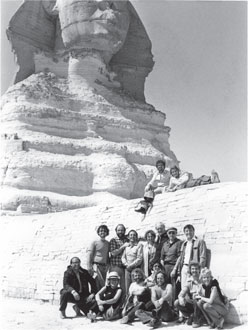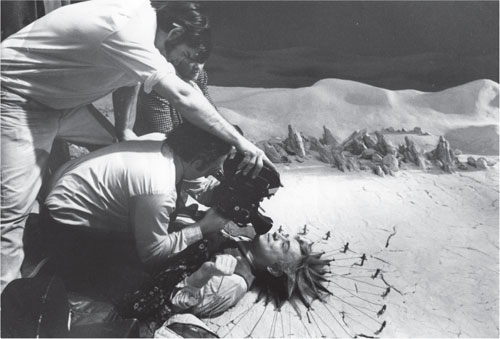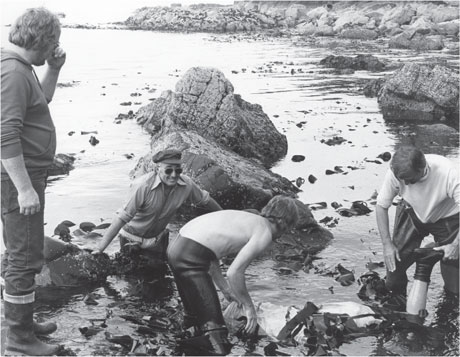Read Shooting 007: And Other Celluloid Adventures Online
Authors: Sir Roger Moore Alec Mills
Shooting 007: And Other Celluloid Adventures (30 page)
Sphinx
(1980) – Elliott’s masterpiece, giving new meaning to the expression ‘skeleton film crew’!
With Ernie’s forewarning, I prepared myself for my meeting with Mr Schaffner by carefully researching his films with questions which I might ask about
The Boys from Brazil
,
Papillon
or
Nicholas and Alexandra
(the list goes on), hoping at least that this would impress the director. Sadly I never got the opportunity.
The first week of filming was not easy; communication of any kind with the director was almost impossible as he quietly sat in his chair, preferring to ignore me, the stern look on his face permanently imprinted, warning off any contact – just as Ernie had predicted. The director’s expression gave little away apart from the occasional rub of the chin as his cold stare surveyed all that went on around. Try as hard as I might, my efforts to win him over would be in vain – a hopeless situation for any camera operator. When the director joined me up on the camera crane I thought this would be the ideal time to break the ice, but again my attempts failed miserably and it would seem that Mr Schaffner was more interested in the activities going on below us than having a chat with me. Apart from telling me of his requirements, the director hardly spoke to me. With little sign of any communication between us the first week passed very slowly …
So came the start of the second week, when the real Franklin Schaffner appeared on the set: different, polite, well mannered and fun.
‘Good morning, Alec, and how are you this fine day?’
Ernie’s accurate description of the director was now confirmed; it would seem that I had passed the director’s assessment of me as Franklin apparently was not one to stand fools gladly and needed to establish where the weaknesses lay in his crew. With the director’s soft tone I felt more comfortable, knowing that I had passed his examination and from now on I would enjoy a close relationship with the boss, a humorist who played his part in the Anglo-American sense of humour which he enjoyed sharing with Frank Elliott.
With our filming completed in Budapest we moved to Egypt, filming the customary tourist locations of Cairo, the Valley of Kings and Luxor. We were filming at a time when the hotels were usually full up with tourists; as a result, the unit’s accommodations would be split up, with Frank and me finding ourselves billeted on a houseboat which normally cruised up and down the Nile, bringing back memories of the John Guillermin experience on
Death on the Nile
– this time without the associated hassle.
The boat was pleasant enough if a little cramped, but generally everything worked out surprisingly well; I would even admit to enjoying the experience. Others preferred accommodation elsewhere, but for Frank and me the boat would make a pleasant change, just as it would for our historical researcher working on the film. He was a kindly gentleman who pored over his reference books with little interest in all that went on around – a typical boffin both in manner and appearance – the perfect candidate to suffer Frank’s wicked sense of humour. Sitting in the lounge one evening, Frank started speaking to me in a whispered tone, which I assumed was so as not to disturb the expert as he bent over his reference books near us, just close enough to hear what Frank was saying: ‘She came to my room after everyone went to bed!’

Another shot of the usual suspects beside the Great Sphinx at Giza. Director Franklin Schaffner in his black jacket stands over my shoulder, with cinematographer Ernie Day standing to the right. Miki Thomas (clappers) and Frank Elliott (focus) stand to the left in the back row, with Chunky Huse (grip) once again front and centre in the front row.
For a moment I thought Frank was serious before suddenly realising what he was up to, so now I had to respond to this untimely conversation. With my curiosity awakened to see where he was heading, Frank continued to reel him in. Needless to say, the researcher’s interest in his book changed, and he was soon eavesdropping as the discussion continued and no more pages would be turned over until we went to bed!
Sphinx
was an archaeological adventure film and during our filming in the Valley of Kings the production was given permission to film a scene inside Tutankhamen’s tomb. Such a thing was unheard of at the time, with some of the more superstitious unit members jokingly regarding it as tempting fate, deciding that, like Lord Carnarvon, those who entered the king’s chamber would surely die. I will leave it there, not wanting to tempt the outcome in any way …
Inevitably, our location filming would end in Cairo, where our work enjoyed the picture-postcard backgrounds of the Pyramids and Sphinx at Giza, providing an interesting visual atmosphere even if adding little to the story. However, the critics, weary of the number of films based around Ancient Egypt which all appeared to come out at the same time, would not be fooled with their reviews. Perhaps it was time for them to turn their talents to ridicule, unless it really was the curse of King Tut getting his revenge for our disturbing his rest. Lesley-Anne Down, Frank Langella and John Gielgud survived the experience and tried to get something from this very thin script involving murder, forgery and the black market, but generally I would agree with the critics.
You win some, you lose some!
There are times when you recall strange things happening. One such time was when the heavy rain beating down on my window woke me; the dark skies outside produced a strange reflection of my face mirrored in the glass, giving an appearance of tears falling down my cheeks – a weird moment that I remember to this day. Perhaps my distant thoughts were of my constant travelling around the world which had excited me in the past, but now with age moving on I was not so sure that this enthusiasm existed any more.
With all the merry-go-round of foreign travel around the world,
Eye of the Needle
would make a pleasant change with our wartime story being filmed on the rugged island of Mull, the perfect setting for the film version of Ken Follett’s novel
Storm Island
, allowing Alan Hume’s fine ‘painting’ to capture the island’s bleak isolation.
It had been many years since I had last worked with Alan. I had first been his focus puller in 1964 on
Carry on Cleo
– possibly my favourite of the Carry On films – before operating for him thirteen years later on Peter Hunt’s
Gulliver’s Travels
, so I looked forward to working with him again. There was more to Alan Hume than met the eye; without doubt he was one of the most pleasant cinematographers with whom one could possibly work. My recollection of Alan is of his wonderful sense of humour and his daily struggle in trying to control his laughing on the set with the clowning around of the Carry On gang. Alan practically cried with laughter until the tears ran down his cheeks as he tried to compose himself; I would be in good company here.
Mull, one of the largest islands of the Inner Hebrides, could easily be described as an open door to nature’s weather. Cold, rainy and windy followed by more rain, the sun appeared to deny the island’s existence that year, which in a strange way helped the dramatic setting to the story, where our filming rarely stopped in the ever-changing conditions – a problem which would test any cinematographer’s patience to the full, just as it did for Alan. Any thoughts he had of lighting continuity would quickly go out of the window, though in the end this would prove to be a bonus for this interesting wartime story.

Gulliver’s Travels
, directed by Peter Hunt; my first film operating for Alan Hume. While I operated a close shot on Richard Harris with an old Arri IIC and 9.8mm Kinoptic lens, the animated Lilliputians would be added in post-production. My grip helping to steady the camera is Colin Manning.
Working with home-grown and international cinematographers over the years one gets an insight into their individual inner strengths. It could be their technical expertise, personal temperament or just that he was a very nice guy with bundles of energy. Alan Hume was blessed with all of these qualities. Recalling the films we shared together over the years, including
Third Man on the Mountain
,
Kidnapped
,
Wombling Free
(one to forget),
Shout at the Devil
,
The Spy Who Loved Me
,
Carry on Cleo
,
Gulliver’s Travels
,
For Your Eyes Only
,
Octopussy
,
Eye of the Needle
and
Return of the Jedi
, I can now claim to understand him well; the label I would place on Alan Hume would read, ‘the director’s ideal cinematographer’.
It may seem strange and perhaps difficult to explain, but after this preamble of Alan and his temperament I found myself questioning my own personality, which struck a chord with a memory from my early years back in my Carlton Hill Studio days.

Filming part of the Allies’ phantom army discovered by the Nazi spy on
Eye of the Needle
(1980). Director Richard Marquand sitting with back to camera and focus puller Mike Frift.

Who was it who said that the film business was glamorous?
